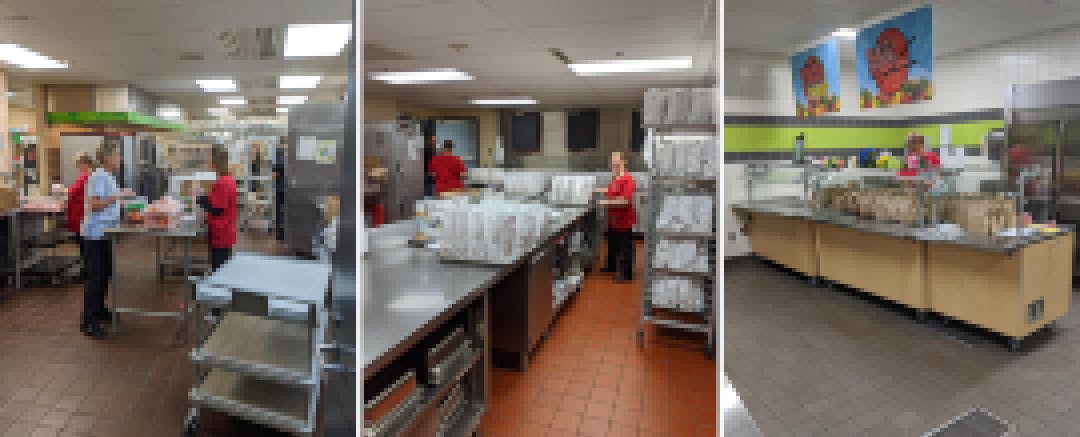In the food service business, it is wise to have a Plan B at all times. And, for good measure, probably a Plan C, too.
On any given day, the food delivery may not arrive on time. Or, when it gets there, half of the supply has spoiled and needs to be thrown out.
“You make decisions knowing they might change,” says Beth Kujawa, the food services supervisor at Leyden High School District 212, located just outside of Chicago.
This is a fact understood—and accounted for—across the school food service industry.
“You always have a contingency plan in place, in case you have a disaster at one of your school sites,” notes Michelle Jones, general manager of food services at Minnesota’s Independent School District 728.
But, Jones continues, “I don’t think anyone foreshadowed something like this happening.”
“This”—the outbreak of COVID-19 in the U.S.—happened quickly and, for many districts, all at once. Announcements about school closures came, perhaps ominously, on Friday, March 13. Many educators and students learned that buildings would be closed beginning the following Monday, with no real sense of when they might reopen.
With nearly 30 million children across the U.S. relying on their schools to receive daily discounted or free meals, that presented a serious logistical problem.
That weekend, as public school districts all over the country scrambled to come up with plans for delivering instruction, their food service staff were trying to figure out how they would prepare and provide meals to thousands of students in their district who depend on them each day.
The moment required creativity, committed workers and swift action.
“We brought up an entirely new food service operation in two days,” says Kimberly Eisenschenk, executive director of business services at ISD 728.
Kujawa recalls a similar urgency at her district in Illinois: “We left with regular service Friday, then came back Monday to this whole new way of doing things.”
Ever since, food service staff from coast to coast have risen with the sun every weekday—including, for many, on holidays like Good Friday and during Spring Break—to head to their school buildings and begin the arduous process of preparing, cooking and distributing meals to their school communities. To many, their jobs may be assumed, even invisible.
But the role of food service staff in the larger remote learning experiment is not to be understated. It’s hard for students to focus on academics—or really anything else—if they’re hungry. And research shows that children who eat nutritious meals, especially breakfast, are more available to learning and cognitive development.
“Lunch ladies are often the unsung heroes of the school,” says Kujawa. “People think they’re just handing the kids a plate and that’s it. But lots of time they’re giving the kids a smile and making them feel comfortable. … It’s very rewarding.”
AT LEYDEN, A SUBURBAN DISTRICT that wraps around Chicago’s O’Hare Airport, most of the 3,500 students come from low-income families and are eligible for free and reduced-price meals through the National School Lunch Program.
Before the pandemic, Kujawa and her staff of about 35 would prepare 600 breakfasts and 2,000 lunches per day. But as of March 16, the program has served as many as 4,100 meals a day.
One reason is that more children are eating school-provided breakfasts than usual. Like many other districts, Leyden is inviting families to pick up meals on site, where they get a bag that contains both lunch for that day and breakfast for the following day. Kujawa says they’re also serving others outside their student body; anyone ages 18 and under in the community is eligible for the free meals at Leyden, including the elementary school students in the area.
“If a mom walks up saying she has three children, we hand her three bags,” Kujawa says, noting that they are operating on the honor system.
In her kitchen, cooks arrive around 7 a.m., with everyone else in by 8 o’clock. They prep and cook the food, then buses arrive around 10:30 to collect the meals and take them to the seven pick-up sites. Distribution takes place from 11 a.m. to noon every weekday. By 12:30 p.m., the buses are back, the staff cleans up the kitchen, and everyone heads home around 2 p.m.
“At first it was scary,” Kujawa admits. “There were a lot of unanswered questions: ‘How will we do this? How long will we do it? Are we safe?’ I was definitely having to validate [my staff’s] fears, saying, ‘We’re doing everything we can.’”
She adds that, from the very first day, she’s been clear that anyone on her team who does not feel well or just feels uncomfortable continuing to come to work should stay home.

The early days were “emotionally straining,” Kujawa says. “But it evolved.”
After two or three weeks, they hit their stride. That’s when they started to throw in a little something extra in the sack meals. They’d add notes in with the bags, or write uplifting messages in Sharpie on the bananas—things like, “Hang in there,” “We miss you” and “You’re special.”
“Just pretty much letting them know we’re thinking about them,” Kujawa explains.
ONE OF THE BIGGEST ADJUSTMENTS for the food staff at Eatonville School District in Washington state has been the lack of variety, says Terry High, the food services manager.
“We have so many different choices during a regular school day ... six to eight choices a day,” says High, ticking off the different options: pizza, hot meals, burgers, chicken burgers and so on. But these days, the menu is pretty limited. Students can choose between a salad or a sack meal, and between chocolate milk or white milk.
“Prepping-wise, I think it’s easier,” says High, “but the mental part is you get tired, like, ‘Can’t we go back to the regular way?’”
Eatonville serves just 2,000 students, but situated at the base of Mt. Rainier, it covers a wide and mountainous geographic area. The drive from one school site to the next can be as far as 16 miles, High says. That made the logistics of meal prep and deliveries a bit more challenging early on, but “we got a handle on it right away,” High says.
In the beginning, families that showed up were inclined to park and hop out of their cars to collect their meals. But for health and safety reasons, the staff has since enforced a near contactless system.
Now, when families arrive at the designated pick-up sites, they stay in their cars. They simply pull up, roll down their window and tell one of the staff how many meals they need. “Then that [staff member] hollers to the next, ‘Three meals, one salad, two sack, all chocolate milk,’” High explains. Then the car leaves and a staff member sanitizes the tables.
At Eatonville, the food service staff is all female, High says. “I told ‘em all from the get-go, ‘Listen, girls, if you want to work, I’ll keep you working. But if you don’t want to be here, you gotta let me know.’” All but two of them, including High, who is 65 years old, have young children at home. “They’re all leaving their kids every day to come and do this for somebody else’s kids.”

AT ISD 728, WHICH SERVES 14,000 STUDENTS and is located in the suburbs of Minneapolis/St. Paul, the 100-person food service staff typically prepares 2,000 breakfasts and 7,000 lunches per day, according to Jones, the food service manager. When the district’s emergency food service program began under COVID-19, they were providing about 6,000 meals a day.
As the weeks passed, more families started showing up. By early May, they were providing nearly 9,000 meals a day—about the volume they were accustomed to before the closures, but with half the staff.

Like Leyden and Eatonville, staff at ISD 728 practice social distancing in the kitchens and throughout their shifts, standing at least six feet apart during food prep, despite the assembly-line-style production that is necessary to make thousands of meals in just a few hours.
“This is tough work. It’s exhausting work,” says Jones. “Preparing meals is physically demanding. Putting food into bags 9,000 times is a lot of motion.”
The emotional and physical labor is taking a toll on her staff, Jones says. They’re tired. But one thing that never fails to energize them is seeing and connecting with students during pick-ups.
“We receive countless thank-yous and have really emotional connections with our parents and students who are really relying on us,” Jones says. “It keeps our staff going day after day.”
An especially welcome surprise arrived last month. A Domino’s Pizza delivery driver pulled into the pick-up line, stepped out of his car and said, “I have a delivery for you. A student wanted to buy lunch for you for a change.” The driver left several boxes of pizza on the table—enough to feed about 35 employees.
Even better, the staff learned that the delivery came from an elementary school student—probably 7 or 8 years old, Jones guesses—who they regularly see picking up lunch from one of their sites. He’d just had a birthday in April, and used his birthday money to order the pizza for the ISD 728 food service staff. “We didn’t have any indication he was going to do that,” Jones says. “It was wholesome and caring, just very sweet.”
Staff also get occasional calls from parents, who, sometimes through tears, thank them for continuing to provide meals to their children. They say they don’t know what they’d be doing to feed their children if that option weren’t available.
The outpouring of love and appreciation is passed back and forth. The food service staff sometimes write messages in chalk to students and families, which they can see as they drive up to pick up the meals. Other times the kids will show up and write messages to the staff. Sentiments such as, “We’re thinking about you” or “We’ll get through this” are common, Jones says.
Now, the food service staff have their eyes on a much-needed break. ISD 728 plans to wrap up its meal service when the school year ends on June 4. Leyden would ordinarily wrap up its operations by Memorial Day, but they’ve extended the program through June.
At Eatonville, the food service workers’ last day is slated for June 16.
“When I told them that,” High recalls, “you could see their relief. It is going to be over eventually.”


